Try this aggressive half-court defense
There aren’t a lot of secrets in basketball anymore. There’s too much exposure.
The key is how hard are you willing to work to get your players to implement your game plan day-in and day-out in both practice and in games.
If you have a team that’s good on the defensive end of the court, you have a chance to win the basketball game, or at least still be in it at the end. If you can’t stop your opponent, you don’t have a chance. A successful defensive philosophy is based on accomplishing four objectives:• Attitude. Your players must develop the proper attitude about defense.
• Be Aggressive. Your players have to be aggressive with everything they do.
• Challenge Everything. Players must challenge the shot, every pass, every dribble and their ability to get to the board for rebounds.
• No-Fear Approach. Players shouldn’t have any fear or doubt about what they’re doing.
Establish ‘defensive’ attitude
The best way to instill the importance of playing with an attitude on defense is by making your players aware of several tendencies or characteristics which all successful defenses have. Stress these defensive fundamentals:
• Pressure the Ball. Teach your players to work hard and put good pressure on the ball.
• Get Into Passing Lanes. Have them work hard to get at least a hand into the passing lanes.
• Get a Hand Up on Every Shot. Whether it’s in the post or out on the perimeter, your players must get a hand up on every shot.
• Force Mistakes. Make the opponent play faster than what they’re normally used to playing. Force them into turnovers.
• Rebound! After pressuring the ball, playing the passing lanes and getting a hand up on the shot, the play is not complete until our players have rebounded the basketball.
Drills to establish attitude
To get your players to develop the proper attitude and utilize an aggressive approach on defense, emphasize defense in practice. Playing challenging defense requires hard work in drills and scrimmages.
Here are several drills you can run daily to get players focused on playing an aggressive, challenging style of defense.
Deny drills
Work hard on denying the ball so your defense always has a hand in the passing lane. You want players to be in a position where they have only a hand in the passing lane and not their whole body.
Stress to your players not to let the offensive player initiate contact to get open and keep them aware of the ball and their man at all times. Deny ball reversal passes and keep the ball on one side of the floor.

Diagram 1: This is an example of poor deny positioning. To get into proper position to deny the ball and get a hand in the passing lane, the defensive player has to be on the same floorboard as the offensive player. Each defender must be in a good initial defensive position when the ball crosses midcourt, ready to play defense right away.

Diagram 2: Here’s the proper alignment to deny the passing lanes.
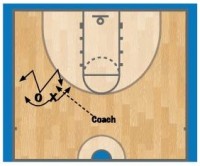
Diagram 3: This 1-on-1 drill with a coach is a basic drill to work on deny positioning. The offensive player works to get open for the pass, while the defender works hard to deny them the basketball.
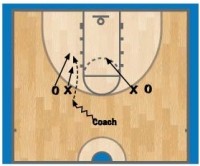
Diagram 4: The two-man deny drill is the same as the 1-on-1, only this drill involves more players and gives the coach the option to go to either side. When the ball is dribbled to one side, the opposite defender can drop back and help on the backdoor.
Jam the post
When we get caught behind in post defense and the offensive player receives the ball, we “jam the post” right after the pass with double and triple teams to force the player to throw the ball back to the perimeter. Most post players are not accomplished passers, so this present opportunities to get easy turnovers or deflections.
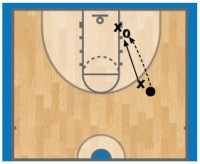
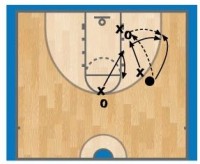
Diagrams 5 & 6: These diagrams show how to attack and crowd the post after a player receives the ball and forces them to throw the ball back out to the perimeter.
Deny the post drills
You want to make it as difficult as possible for the offense to get the ball into the post. This means fronting the post player to deny them the basketball. The post defender must deny the ball by getting their whole body in front of the offensive player with one hand up and one hand down. With good pressure on the ball, it allows the post defender enough time to move around in front. When played properly, the only pass that will work to get the ball into the post is a lob, which gives your back side defenders enough time to slide over and help.
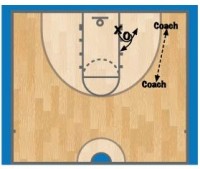
Diagram 7: This is the best drill to show post defenders the proper technique for denying the post.
Position two coaches (or a coach and a player) on the wing and baseline and have the defender work on getting around the offensive player into deny position. The defender works on sliding low to high as the ball is passes back and forth on the perimeter.
Support the drive
By playing an aggressive pressure defense, it’s inevitable that you are going to get beat off the dribble and defending this situation is one of the hardest things your players have to do. Not only do defenders have to be in position to deny the passing lanes, but they have to be able to slide and help on the penetration, yet still recover quickly back to their man.
How you choose to stop dribble penetration will vary from game to game depending on scouting and opponent strengths. Whether you choose to bluff the help or support the drive to stop the penetration should be determined through scouting.
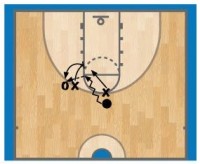

Diagrams 8 & 9: Use these drills to support the drive to stop penetration. In both cases, the supporting defender has to work hard to slide and stop the drive, then scramble hard to recover back to their man.
Mix your post players with guards in these drills because your big players often end up guarding a smaller player in a game.
Sideline defense
When the ball is on the wing, the defender should be on the same floorboard as the offensive player. Play aggressive on the ball and force the ball to the baseline and eliminate the offensive player’s ability to drive the ball back to the middle. Keeping the ball away from the middle of the floor limits offensive options, optimizes the rotation and help off the dribble.

Diagram 10: Forcing the wing to the baseline allows you to be aggressive and keeps the rotation in good shape.

Diagram 11: When you allow the ball back into the middle of the floor, supporting defenders are caught in between, the rotation is less effective and the offense has multiple options.












